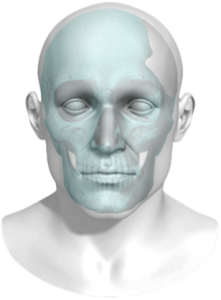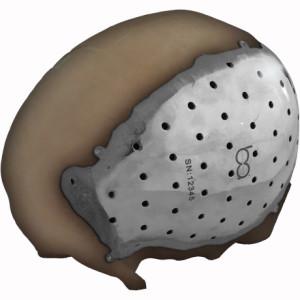 A facial injury or deformity is one of the most traumatizing things that can happen to a person. There’s the inevitable social stigma, the discomfort with being in public, but a severe injury to the face or head can interfere with vital functions – breathing, eating, etc. For a long time, there was only so much that could be done to repair damage to the face; risk could be minimized, but people were often left with major scarring for life. That’s changed very quickly in recent years as 3D printing has made it possible to reconstruct bones, muscles and even skin, and the technology hasn’t stopped advancing.
A facial injury or deformity is one of the most traumatizing things that can happen to a person. There’s the inevitable social stigma, the discomfort with being in public, but a severe injury to the face or head can interfere with vital functions – breathing, eating, etc. For a long time, there was only so much that could be done to repair damage to the face; risk could be minimized, but people were often left with major scarring for life. That’s changed very quickly in recent years as 3D printing has made it possible to reconstruct bones, muscles and even skin, and the technology hasn’t stopped advancing.
 BioArchitects, which operates out of both the United States and Brazil, specializes in reconstructive implants. While many medical companies are beginning to incorporate 3D printing into their surgical devices and procedures, BioArchitects has been using it exclusively for their surgical models and implants. Their patient-specific implants, customized to replace hard tissue, are 3D printed with a biocompatible titanium alloy that causes no adverse reaction and improves patient outcomes.
BioArchitects, which operates out of both the United States and Brazil, specializes in reconstructive implants. While many medical companies are beginning to incorporate 3D printing into their surgical devices and procedures, BioArchitects has been using it exclusively for their surgical models and implants. Their patient-specific implants, customized to replace hard tissue, are 3D printed with a biocompatible titanium alloy that causes no adverse reaction and improves patient outcomes.
Today, BioArchitects announced that their 3D printed, patient-specific titanium cranial/craniofacial implant has been granted 510(k) clearance by the FDA. This is big news because it allows the company to begin marketing the device, the first of its kind in the United States.
“We are extremely proud to contribute to what we consider another major advance in the trend toward personalized medicine,” said Mark Ulrich, CEO of BioArchitects USA. “We believe that this is yet another step toward what will ultimately become the new standard of care.”
 The titanium plate was designed to repair defects and damage to the non-loadbearing bones in the head and face. A CT or MRI scan is taken of the patient’s head, and the images are used to print a titanium plate that precisely fits the damaged area – “not unlike the positioning of a jigsaw puzzle,” according to BioArchitects. The implant is attached to the surrounding bone using self-tapping titanium screws.
The titanium plate was designed to repair defects and damage to the non-loadbearing bones in the head and face. A CT or MRI scan is taken of the patient’s head, and the images are used to print a titanium plate that precisely fits the damaged area – “not unlike the positioning of a jigsaw puzzle,” according to BioArchitects. The implant is attached to the surrounding bone using self-tapping titanium screws.
The devices are printed using electron beam melting (EBM) technology, patented by metal additive manufacturing corporation Arcam AB. The process, which – as its name suggests – uses electron beams to melt and fuse metal powders at high temperature and high speed, resulting in metal products that are lightweight, strong and incredibly precise – properties that have made the technology very popular in the manufacture of orthopedic devices and implants.
“BioArchitects is a prime example of how innovative organizations are using EBM technology to advance biomedical surgeries that truly effect people’s lives,” said Magnus René, CEO of the Arcam Group. “Arcam has been a strategic supplier to the orthopedic market for over a decade and tens of thousands of implants are made yearly from our EBM systems. It is clear that both BioArchitects and Arcam are advancing patient care with new technologies that will make a significant difference in the world of medicine for years to come.”
Discuss these new medical devices in the 3D Printed Titanium Implants forum over at 3DPB.com.
Subscribe to Our Email Newsletter
Stay up-to-date on all the latest news from the 3D printing industry and receive information and offers from third party vendors.
You May Also Like
3D Printing Unpeeled: Wind Turbines, Probiotics and Lenses
TPI Composites, ORNL and Ingersoll Rand are working to make wind turbine tooling segments that can be 18.3 meters long. These elements also include resistive wires that help keep the...
3D Printing Unpeeled: Digital FDM Filament for Functional Gradients
Just published in Nature, a paper by a Seoul National University team looks at “3D printing with a 3D printed digital material filament for programming functional gradients.” Sang-Joon Ahn, Howon...
3D Printing Unpeeled: $5000 Cold Spray 3D Printer, Roland DGA & Living Materials
The AeroForge is a $5000 cold spray metal printer for copper made by a student team at Rice University. In a paper for ACS Central Science a team from Nanjing...
3D Printing Webinar and Event Roundup: April 28, 2024
In this week’s 3D Printing Webinar and Event Roundup, the Ceramics Expo is taking place in Michigan, Stratasys continues its advanced training courses, and SPE is holding a Polymer Characterization...
































